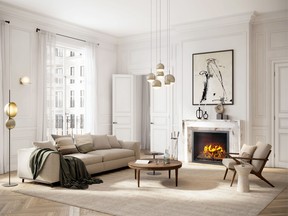Entertainment
Discover the Latest Trends in Fireplaces for Your Home

As homeowners increasingly seek warmth and aesthetics, the fireplace industry is witnessing a surge in innovative trends. Key among these is a movement towards enhanced realism in fireplace designs. According to Garry Scott, vice president of marketing at Napoleon, consumers are gravitating towards ultra-realistic flames, made possible by advanced gas burners and electric units that simulate the visual and auditory experience of a traditional fire.
The latest designs incorporate minimalist frames and traditional square styles, blending modern aesthetics with classic appeal. Electric fireplaces now offer lifelike flames paired with a variety of colours and sound effects, creating an immersive atmosphere. Additionally, features like heat management systems allow homeowners to enjoy the ambiance of a fire throughout the year, directing warmth to other rooms or outdoor spaces.
Sonia Presotto from Concord Fireplaces Inc. emphasizes the importance of authenticity in heating. “Gas delivers the most realistic flame and highest heat,” she explains. “Electric models have advanced significantly, now including options for colour, sound, and smart-home integration.” She notes that innovative designs also include enhanced logs and refined finishes, which contribute to the layered flame effects consumers desire.
Choosing the Right Fireplace for Your Needs
When selecting a fireplace, it is crucial to define its primary purpose—whether for heating, ambiance, or both. Scott advises that understanding the intended use will influence the size, fuel type, and installation requirements. Gas and wood fireplaces typically provide higher heat output, while electric models offer flexibility in installation and design.
“Each fuel type presents distinct heat capabilities and installation needs,” Presotto adds. “Room size is a critical factor in determining the appropriate British Thermal Unit (BTU) output for comfort.” Potential buyers should also consider their design preferences, whether leaning towards traditional styles or modern, linear models.
Presotto suggests arriving at consultations with ideas and measurements. “The better we understand your project, the better we can guide you,” she asserts. This approach enables professionals to match clients with a fireplace that suits both their aesthetic and practical needs.
Considerations for Converting Existing Fireplaces
For those contemplating a conversion from wood-burning to gas or electric fireplaces, several factors must be assessed. Presotto points out that space and structural conditions play a significant role in these conversions. For instance, wood-burning fireplaces generally require a gas insert tailored to the dimensions of the existing firebox, which may necessitate modifications to the wall and surrounding structure.
Moreover, a certified Wood Energy Technical Transfer (WETT) inspection is essential for ensuring chimney safety and compliance. Any gas-related work must be conducted by a licensed technician. “Not every existing fireplace can safely convert to gas,” Presotto warns, highlighting the importance of evaluating chimney condition and access to utilities.
Electric conversions often present a simpler alternative, especially when conducted following a professional inspection. Homeowners should also consider their budget early in the process, as conversion work tends to be more complex than simply replacing the unit.
Before making a decision, Scott advises assessing local codes, utility access, and venting requirements to ensure a safe and efficient upgrade. With the right approach, homeowners can revamp outdated hearths into clean and efficient focal points in their homes.
Enhancing Outdoor Spaces with Fire Features
As outdoor living spaces gain popularity, fire features are becoming essential for creating inviting environments. Presotto explains that fire tables offer flexibility in placement, particularly when using propane, while outdoor fireplaces serve as architectural elements that anchor seating areas.
Homeowners should consider their intended use for outdoor spaces. “Do you want a seasonal gathering spot or a year-round destination?” she asks. Pairing fire features with outdoor heating solutions can extend the patio season into the cooler months.
Fuel choice is a critical consideration for outdoor installations. Although installing a gas line incurs higher initial costs compared to propane options, it provides greater convenience in the long run. Both propane and gas installations offer a range of excellent product options, catering to diverse preferences.
Ultimately, outdoor fireplaces and fire tables can transform patios into inviting retreats, but careful thought about placement, fuel type, and climate durability remains essential for achieving long-term satisfaction.
As the fireplace market evolves, homeowners have more options than ever to create both functional and aesthetically pleasing spaces, whether indoors or outdoors.
-

 Politics2 weeks ago
Politics2 weeks agoSecwepemc First Nation Seeks Aboriginal Title Over Kamloops Area
-

 World4 months ago
World4 months agoScientists Unearth Ancient Antarctic Ice to Unlock Climate Secrets
-

 Entertainment4 months ago
Entertainment4 months agoTrump and McCormick to Announce $70 Billion Energy Investments
-

 Lifestyle4 months ago
Lifestyle4 months agoTransLink Launches Food Truck Program to Boost Revenue in Vancouver
-

 Science4 months ago
Science4 months agoFour Astronauts Return to Earth After International Space Station Mission
-

 Technology3 months ago
Technology3 months agoApple Notes Enhances Functionality with Markdown Support in macOS 26
-

 Top Stories1 month ago
Top Stories1 month agoUrgent Update: Fatal Crash on Highway 99 Claims Life of Pitt Meadows Man
-

 Sports4 months ago
Sports4 months agoSearch Underway for Missing Hunter Amid Hokkaido Bear Emergency
-

 Politics4 months ago
Politics4 months agoUkrainian Tennis Star Elina Svitolina Faces Death Threats Online
-

 Politics4 months ago
Politics4 months agoCarney Engages First Nations Leaders at Development Law Summit
-

 Lifestyle2 months ago
Lifestyle2 months agoManitoba’s Burger Champion Shines Again Amid Dining Innovations
-

 Technology4 months ago
Technology4 months agoFrosthaven Launches Early Access on July 31, 2025









